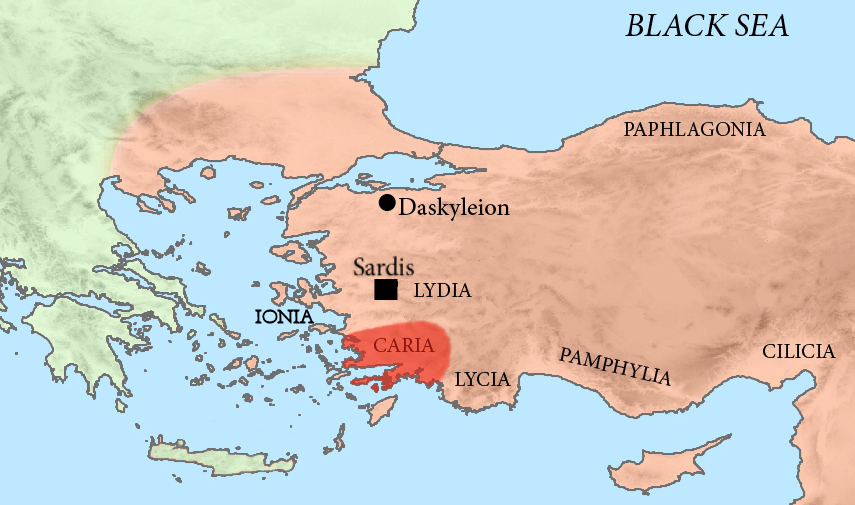|
Lygdamis (genus)
Lygdamis may refer to: * Tugdamme (or Lygdamis or Dygdamis), Cimmerian king, 679-640 BCE * Lygdamis of Naxos, tyrant of Naxos Island in 545–524 BCE * Lygdamis of Halicarnassus, satrap of Caria in the 6th century BC, father of Artemisia I of Caria * Lygdamis II of Halicarnassus Lygdamis II ( gr, Λύγδαμις) (ruled c.460-454 BCE) was a tyrant of Caria during the 5th century BCE, under the Achaemenid Empire. His capital was in Halicarnassus. He was the grandson of Artemisia, and son of Pisindelis, the previous tyran ..., tyrant of Halicarnassus in the 5th century BC, grandson of Artemisia I of Caria * ''Lygdamis'' (genus), a bristleworm in family Sabellariidae {{hndis ... [...More Info...] [...Related Items...] OR: [Wikipedia] [Google] [Baidu] |
Tugdamme
Tugdamme or Dugdammi (Akkadian: or ; Ancient Greek: , ; Latin: ) was a Cimmerian king of the mid-seventh century BC. Name Akkadian ( or ) and Ancient Greek () are derived from a name in a Cimmerian dialect of the Old Iranian Scythian language. The linguist János Harmatta reconstructed this original Cimmerian name as , meaning "giving happiness." The Iranologist Ľubomír Novák has noted that the attestation of the name in the forms and in Akkadian and the forms and in Greek shows that its first consonant had experienced the change of the sound /d/ to /l/, which is consistent with the phonetic changes attested in the Scythian languages. The Scythologist Askold Ivantchik has instead suggested that the name / was a loanword from an Anatolian language, more specifically Luwian, while also accepting the alternative possibility of a derivation from a variant of the name of the Hurrian deity / . Historical background In the 8th and 7th centuries BCE, a significant moveme ... [...More Info...] [...Related Items...] OR: [Wikipedia] [Google] [Baidu] |
Lygdamis Of Naxos
Lygdamis ( el, Λύγδαμις) was the tyrant of Naxos Island, Naxos, an island in the Cyclades, during the third quarter of the 6th Century BC. He was initially a member of the oligarchy which ruled Naxos. In 546 BC, Lygdamis supported the former Ancient Athens, Athenian tyrant Peisistratos in his landing at Marathon, Greece, Marathon, which led to the restoration of Peisistratos to power in Athens. As a reward, Peisistratos helped Lygdamis become tyrant of Naxos or to reclaim that position after losing it.Grant, Michael (1987). ''The Rise of The Greeks''. Guild Publishing London. p. 185 He secured his position by exiling potential rivals and extended his dominance over neighbouring islands such as Paros. Lygdamis contributed a force of Ancient Greek mercenaries, mercenaries to aid his ally Polycrates, the powerful tyrant of Samos, in his campaigns against Miletus and Mytilene. Lygdamis had an ambitious building program and in 530 BC he began work on a huge Temple of Apollo wh ... [...More Info...] [...Related Items...] OR: [Wikipedia] [Google] [Baidu] |
Lygdamis Of Halicarnassus
Lygdamis ( gr, Λύγδαμις), who ruled –484 BCE, was the first tyrant of Caria under the Achaemenid Empire. He was of Carian-Greek ethnicity. He was the father of Artemisia I of Caria. He is the founder of the eponymous Lygdamid dynasty (520–450 BCE) of Carian tyrants, who ruled from Halicarnassus Halicarnassus (; grc, Ἁλικαρνᾱσσός ''Halikarnāssós'' or ''Alikarnāssós''; tr, Halikarnas; Carian: 𐊠𐊣𐊫𐊰 𐊴𐊠𐊥𐊵𐊫𐊰 ''alos k̂arnos'') was an ancient Greek city in Caria, in Anatolia. It was located i .... References {{Achaemenid rulers Ancient Halicarnassians Lygdamid dynasty Achaemenid satraps of Caria 6th-century BC Asian monarchs 5th-century BC rulers in Asia Officials of Darius the Great ... [...More Info...] [...Related Items...] OR: [Wikipedia] [Google] [Baidu] |
Lygdamis II Of Halicarnassus
Lygdamis II ( gr, Λύγδαμις) (ruled c.460-454 BCE) was a tyrant of Caria during the 5th century BCE, under the Achaemenid Empire. His capital was in Halicarnassus. He was the grandson of Artemisia, and son of Pisindelis, the previous tyrant. Lygdamis assassinated the poet Panyassis, uncle of famous historian Herodotus, in 461, which forced Herodotus to leave his native city of Halicarnassus, fleeing to the island of Samos. After the death of Lygdamis, circa 454 BCE, Halicarnassus joined the Athenian alliance, known as the Delian League. At that time, Halicarnassus started to appear on the Athenian tribute quota lists. From 395 BCE, Caria would again fall under the control of the Achaemenid Empire and be ruled by a new dynasty of local tyrants, the Hecatomnids The Hecatomnid dynasty or Hecatomnids were the rulers of Caria and surrounding areas BCE. The Hecatomnids were satraps (governors) under the Achaemenid Empire, although they ruled with considerable autonomy, a ... [...More Info...] [...Related Items...] OR: [Wikipedia] [Google] [Baidu] |
Lygdamis (genus)
Lygdamis may refer to: * Tugdamme (or Lygdamis or Dygdamis), Cimmerian king, 679-640 BCE * Lygdamis of Naxos, tyrant of Naxos Island in 545–524 BCE * Lygdamis of Halicarnassus, satrap of Caria in the 6th century BC, father of Artemisia I of Caria * Lygdamis II of Halicarnassus Lygdamis II ( gr, Λύγδαμις) (ruled c.460-454 BCE) was a tyrant of Caria during the 5th century BCE, under the Achaemenid Empire. His capital was in Halicarnassus. He was the grandson of Artemisia, and son of Pisindelis, the previous tyran ..., tyrant of Halicarnassus in the 5th century BC, grandson of Artemisia I of Caria * ''Lygdamis'' (genus), a bristleworm in family Sabellariidae {{hndis ... [...More Info...] [...Related Items...] OR: [Wikipedia] [Google] [Baidu] |

